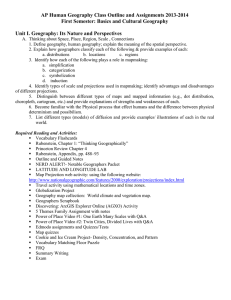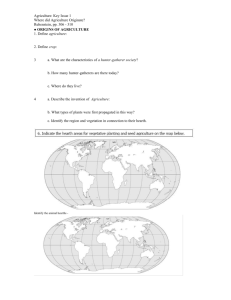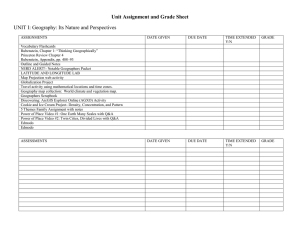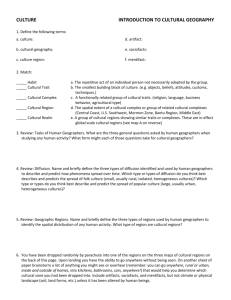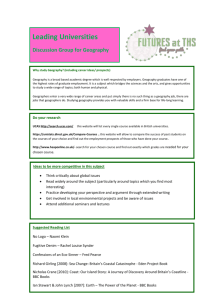AP Human Geography Class Outline and Assignments 2013
advertisement
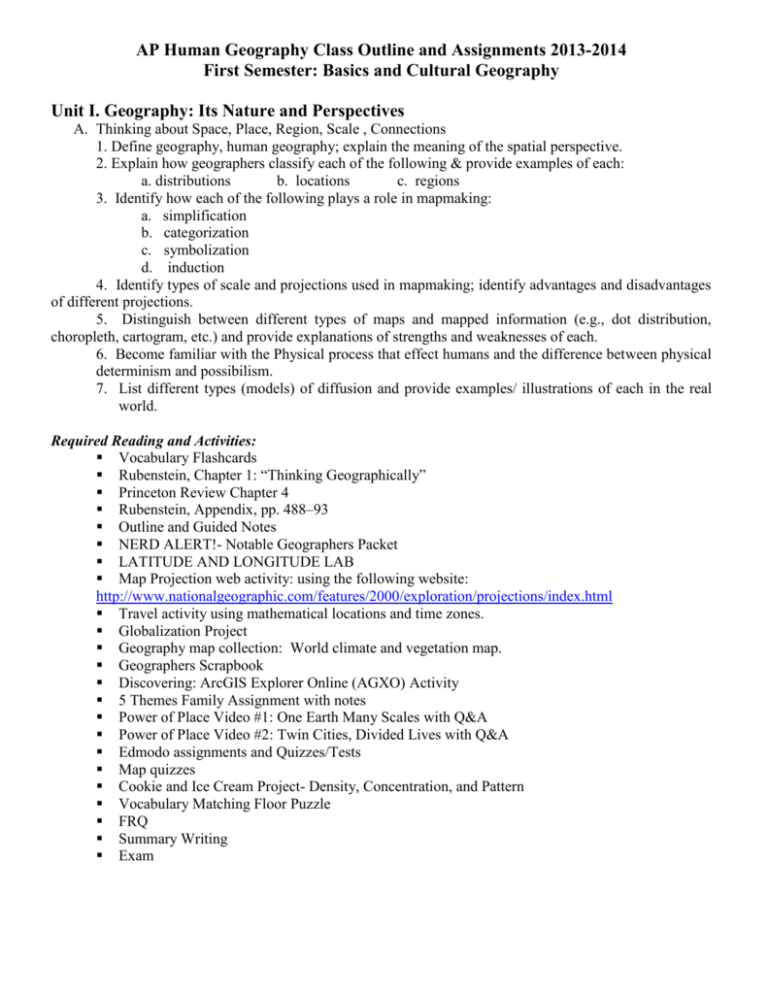
AP Human Geography Class Outline and Assignments 2013-2014 First Semester: Basics and Cultural Geography Unit I. Geography: Its Nature and Perspectives A. Thinking about Space, Place, Region, Scale , Connections 1. Define geography, human geography; explain the meaning of the spatial perspective. 2. Explain how geographers classify each of the following & provide examples of each: a. distributions b. locations c. regions 3. Identify how each of the following plays a role in mapmaking: a. simplification b. categorization c. symbolization d. induction 4. Identify types of scale and projections used in mapmaking; identify advantages and disadvantages of different projections. 5. Distinguish between different types of maps and mapped information (e.g., dot distribution, choropleth, cartogram, etc.) and provide explanations of strengths and weaknesses of each. 6. Become familiar with the Physical process that effect humans and the difference between physical determinism and possibilism. 7. List different types (models) of diffusion and provide examples/ illustrations of each in the real world. Required Reading and Activities: Vocabulary Flashcards Rubenstein, Chapter 1: “Thinking Geographically” Princeton Review Chapter 4 Rubenstein, Appendix, pp. 488–93 Outline and Guided Notes NERD ALERT!- Notable Geographers Packet LATITUDE AND LONGITUDE LAB Map Projection web activity: using the following website: http://www.nationalgeographic.com/features/2000/exploration/projections/index.html Travel activity using mathematical locations and time zones. Globalization Project Geography map collection: World climate and vegetation map. Geographers Scrapbook Discovering: ArcGIS Explorer Online (AGXO) Activity 5 Themes Family Assignment with notes Power of Place Video #1: One Earth Many Scales with Q&A Power of Place Video #2: Twin Cities, Divided Lives with Q&A Edmodo assignments and Quizzes/Tests Map quizzes Cookie and Ice Cream Project- Density, Concentration, and Pattern Vocabulary Matching Floor Puzzle FRQ Summary Writing Exam Unit II. Population and Migration Geography A. Where the World ’s Population Is Distributed 1. Distinguish between and give characteristics of the following types of human movement: a. circulation and migration b. forced and voluntary migration c. push and pull factors B. Where the World ’s Population Has Increased 1. Map major & emerging population concentrations & describe demographic characteristics of each. 2. Consider the concepts of ecumene and nonecumene and consider: a. Why do most people live where they do? b. For what reasons have humans historically avoided certain areas? c. Where do non-examples of each exist? Why? C. Population Is Increasing at Different Rates in Different Countries 1. A Case Study on China’s One Child Policy & Birth Control Measures from Around the World D. Demographic Transition Model 1. Calculate arithmetic, agricultural, and physiological densities and describe the strengths and weaknesses of each for demographic analysis. a. Explain the elements of a population pyramid and distinguish between characteristic shapes. b. Explain the demographic transition model: i. What are its components? ii. Which countries does it describe in each phase? iii. Why might it not predict the future for developing countries today? c. Define key demographic terms/ identify regions in which high and low extreme w/examples Concerning natural hazards, do the following: i. list various types of natural hazards and disasters ii. map the areas most affected by them iii. compare with the map of population distribution E. The World Might Face an Overpopulation Problem 1. A Case Study on Birth and Death rates, modern medicine and the extension of life F. Why People Migrate and the Distribution of Migrants 1. Discuss the contributions of Ravenstein to the study of human movement and migration. 2. Use the gravity model to predict migration and evaluate its efficiency and usefulness. G. Map specific examples of historic and contemporary forced migrations, explaining push and pull factors associated with each. 1. Characterize a refugee and refugee populations. 2. Discuss the migration history of the United States through the following: a. immigration history b. immigration policy H. Obstacles Faced by Migrants 1. Why People Migrate Within a County 2. What effect internal migration has on population 3. historic and contemporary streams of migration internal migration patterns 4. Explain how distance decay, intervening obstacles, and migration selectivity factors affect migration and circulation patterns. 5. Correlate migration patterns to the demographic transition model. Required Reading and Activities: Vocabulary Flashcards Rubenstein, Chapters 2 and 3:“Population ” and “Migration ” Princeton Review Chapter 5 Outline and Guided Notes NERD ALERT!- Notable Geographers Packet Mapping Populations Activity Demographic Transition Model and Population Pyramid Activity- Analyzing data Birth Control Methods around the World: Case Study of the One Child-Policy and on India Parent interview –Family Migration Mapping ACTION-ORIENTED ACTIVITY 3.1: Migration Mania Demographic Statistical Analysis- HDI Reports assignment Census Data- Using census data, create population pyramid for core, periphery and semi-periphery country Human Geography Video: Population Transition in Italy with Q&A Power of Place #2- Boundaries and Borderlands with Q&A Power of Place #18: Oil and Water with Q&A Power of Place #21: Population Geography with Q&A Edmodo assignments and Quizzes/Tests Vocabulary Matching Floor Puzzle FRQs Summary Writing Exam Unit III. Cultural Patterns and Processes Folk and Pop Culture 1. Where Folk and Popular Cultures Originate and Diffuse a. Define culture and cultural geography. b. Compare and contrast the following aspects of folk and popular culture: i. origins ii. methods of diffusion iii. culture regions 2. Folk and Popular Culture and the Cultural Landscape a. Examine specific examples of folk culture and regions. b. Examine examples of specific popular cultural traits and discuss their diffusion. c. Discuss the role of racism and ethnocentrism in the understanding of the cultural landscape. 3. Folk Culture Is Clustered a. Discuss ways in which cultural traits are affected by and affect the natural environment. 4. Popular Culture Is Widely Distributed 5. Globalization of Popular Culture Causes Problems Required Reading and Activities Vocabulary cards Rubenstein, Chapter 4:“Folk and Popular Culture ” Princeton Review Chapter 6, pages 132-139 and 143-147 Outline and Guided Notes NERD ALERT!- Notable Geographers Packet Folk Culture Self-Analysis Research and Mapping Remaining Folk Cultures in the US and World Edmodo assignments and Quizzes/Tests Vocabulary Matching Floor Puzzle FRQs Summary Writing Exam Language 1. Indo-European Languages a. Discuss the importance and role of language as an element of culture. b. Explain how languages are classified and related. c. Map the distribution of major language families worldwide 2. Where English Language Speakers Are Distributed a. Describe the following characteristics of English: i. origin and historical development ii. worldwide diffusion iii. spatial variation iv. role in cultural convergence v. explain the how, why, and where of language change. 3. Where Other Language Families Are Distributed a. Show the division of Europe into the following language groups and give specific examples from major groups: i. Germanic ii. Slavic iii. Romance 4. People Preserve Local Languages a. Discuss the regional and local variety in language using the following terms: i. slang ii. Isogloss iii. accent/dialect b. Explain how toponyms are derived and classified and give various examples. 5. Language as an Identity Required Reading and Activities Vocabulary Cards Rubenstein, Chapter 5:“Language ” Princeton Review Chapter 6, pages 140-142 Outline and Guided Notes NERD ALERT!- Notable Geographers Packet “Should English be made the only language in the United States?”—essay writing exercise Case Study of the British Empire and the Spread of English- Scenes from “My Fair Lady” used English versus American Standard Venn Diagram Language Tree Assignment Dialect and Language Activity Global Mosaic Assignment (Language and Religion) Edmodo assignments and Quizzes/Tests Language Handout Vocabulary Matching Floor Puzzle FRQs Summary Writing Exam Religion 1. Origin and Diffusion of Religions a. Identify the following characteristics of all major religions: i. point of origin ii. method of diffusion iii. current distribution iv. landscape expression b. Map the religious regions of the United States. c. Discuss the major branches, origins, and current distributions of the five major religions 2. Universalizing and Ethnic Religions a. Distinguish between ethnic and universalizing religions: i. holy sites ii. holy day iii. methods of diffusion 3. Religions Organize Space a. Describe ways in which the environment influences religion and ways in which religions affect the natural environment. 4. Territorial Conflicts Arise Among Religious Groups a. Discuss various specific religious conflicts around the world in terms of the following: i. religion versus politics ii. religion versus religion—interfaith conflicts iii. religion versus religion—intrafaith conflicts Required Reading and Activities Vocabulary Cards Rubenstein, Chapter 6:“Religion ” Princeton Review Chapter 6, pages 147-158 Outline and Guided Notes NERD ALERT!- Notable Geographers Packet Research Project on the Abrahamic Religions- Compare and Contrast- Triple Venn Diagram Why can’t the Religions of Abraham Live in Peace?- Case Study on Conflict between Islam. Judaism, and Christianity- Historical to present Jerusalem and the creation of the nation of Israel- timeline Sunni versus Shiite- Peace in the Middle East? Research Project on Religions- Students choose a religion different from their own Edmodo assignments and Quizzes/Tests Power of Place Video #17: Sacred Space, Secular States with Q&A Power of Place #11: A Challenge for Two Cities with Q&A Global Mosaic Assignment (Language and Religion) Vocabulary Matching Floor Puzzle FRQs Summary Writing Exam Ethnicity 1. Distribution of Ethnicities a. Describe the distribution of major ethnicities within the United State identify states/regions in which they are clustered b. Identify regions in which they are mostly absent i. provide reasons for the present distribution ii. examine case studies of ethnic conflicts from different regions. iii. consider ways in which gender-related issues are expressed spatially, particularly: economic roles and activity, health and reproduction, level of education 2. Why Some Ethnicities Have Been Transformed into Nationalities a. Discuss various nation-state configurations and illustrate them with examples: i. nation-state ii. part-nation state iii. multinational state iv. stateless nation 3. The Clash of Ethnicities a. Ethnic Cleansing b. Ethnic Tensions and Wars in Central Eurasia c. South Africa and Apartheid d. Darfar, Chad, and the turmoil in Africa Required Reading Vocabulary Cards Rubenstein, Chapter 7:“Ethnicity ” Princeton Review Chapter 6, pages159-170 Outline and Guided Notes NERD ALERT!- Notable Geographers Packet Research on Ethnic Conflicts of the 20th and 21st Centuries Race: The Power of Illusion- http://www.pbs.org/race/000_General/000_00-Home.htm Power of Place Video #25 Ethnic Fragmentation in Canada with Q&A Power of Place#8 Holding the Hinterlands with Q&A Power of Place #14: The Maritime Connection with Q&A Edmodo assignments and Quizzes/Tests Vocabulary Matching Floor Puzzle FRQs Summary Writing Exam *******END OF SEMESTER PROJECT CHOICES************** Culture Collage Sports league Expansion project Second Semester: Political and Economic Geography Unit IV. Political Geography A. The Difference Between a State and a Nation 1. Define and give examples B. Boundaries 1. Political, ethnic, religious C. Boundary Problems 1. Disputes- ethnic, political, religious 2. Break up of Soviet Union D. Cooperation Between States 1. Interstate Commerce 2. The European Union E. A Look at Terrorism 1. Attacks on American- Pre and Post 9/11 2. Irish Republican Army 3. American Terrorists 4. Middle East and jihad, Africa 5. Bio- Terrorism and Chemical Warfare Required Reading and Activities Vocabulary Flashcards Rubenstein, Chapter 8:“Political Geography ” Princeton Review Chapter 7 Outline and Guided Notes How Do I Become A Citizen? Activity Create Your Own Country Web Quest- THE POLITICAL IMPRINT: ALL NATIONS GREAT AND SMALL NERD ALERT!- Notable Geographers Packet Power of Place #3 Supranationalism and Devolution with Q&A Power of Place #2 Boundaries and Borderlands with Q&A Newsweek, US News and World Report, MSNBC, Fox News Archives Articles and Current Events Country Profile with Rubric Research on Terrorism- History, Goal, Alternatives Vocabulary Matching Floor Puzzle Edmodo assignments and Quizzes/Tests FRQs Summary Writing Exam Unit V. Economic Geography- Development, Industrialization, and Resources Development A. Economic, Social, and Demographic Indicators B. More Developed Regions versus Less Developed Regions 1. Developed- Westernized, Industrialized, And Beyond Industrialized 2. Developing- Transition- Asian Tigers, Celtic Tiger 3. Third World 4. Fourth World C. Obstacles to Development 1. Political 2. Educational 3. Social 4. Geographical Industrialization A. Origins of Industrial Revolution B. Distribution of Industry C. Situation Factors and Site Factors D. Weber’s Industrial Location Model E. Obstacles to Optimum Locations F. Problems Faced by Industry G. A Look at NAFTA and the effect on the economies of Canada, Mexico, and the USA Resources A. Fossil Fuel and Fossil Water Depletion B. Source of Pollution C. Global Food Resources Required Reading and Activities Vocabulary Flashcards Rubenstein, Chapter 9:“Development ” Rubenstein, Chapter 11:“Industry ” Rubenstein, Chapter 14:“Resource Issues ” Princeton Review Chapter 9 Friedman, Thomas L., The World is Flat [Updated and Expanded ]:A Brief History of the TwentyFirst Century. New York: Farrar, Straus and Giroux, 2006. Chapters 1 and 2 are required Outline and Guided Notes NERD ALERT!- Notable Geographers Packet Chocolate and Modern Day Slavery Footprint Internet Activity WORLD ENERGY PATTERNS Activity Thirsty Town Activity- Alfred Weber's Theory of Industrial Location MAPPING THE CORE-PERIPHERY MODEL Activity Is Wal-Mart Good For America? Activity Research- Comparing and Contrasting the Economies of the USA, Mexico, and Canada Research- What’s wrong with the Euro? Power of Place #20 Developing Countries with Q&A Power of Place #5 Transforming Industrial Heartland with Q&A Power of Place #18 Oil and Water (used for Unit II also) with Q&A Power of Place #13 The Mainland with Q&A Power of Place #10 The Booming Maritime Edge with Q&A Edmodo assignments and Quizzes/Tests Vocabulary Matching Floor Puzzle FRQs Summary Writing Exam Unit VI. Agriculture and Rural Land Use versus Urban Patterns & Settlement and Services Agriculture A. Agricultural Hearths 1. Definition and examples B. Classification of Agricultural Regions C. Agriculture in Less Developed Countries D. Agriculture in More Developed Countries E. Economic Issues Involving Agriculture F. Rural Land Use- local, state, and country G. Rural Landscape Analysis Required Reading and Activities Vocabulary Cards Outline and Guided Notes Rubenstein, Chapter 10: “Agriculture” Princeton Review Chapter 8 NERD ALERT!- Notable Geographers Packet Mapping Agricultural Hearths Mapping Crops in Georgia and the US King Corn Activity Green Revolution in India : A Case Study The Meatrix- http://www.themeatrix.com/ with Q&A The Geography of a Breakfast Commodity Team Research Activity Pork and Chicken Writing Activity Power of Place #12 Small Farms, Big Cities with Q&A Power of Place #21 Population Geography – Guatemala with Q&A Power of Place #23 Brazil, The Sleeping Giant with Q&A Power of Place #26 Regions and Economies with Q&A Edmodo assignments and Quizzes/Tests Vocabulary Matching Floor Puzzle FRQs Summary Writing Exam Urban Settlement and Services A. Origin and Location of Urban Areas at Multiple Scales B. Urban Models C. Problems of Inner Cities D. Problems in Suburbs and Exurbs A. Where Services Originated B. Rural Settlements C. Distribution of Services D. Central Place Theory E. Market Area Analysis F. Business Services in Large Settlements G. Central Business District Required Reading &Activities Vocabulary Cards Outline and Guided Notes Rubenstein, Chapter 13:“Urban Patterns ” Rubenstein, Chapter 12:“Services ” Princeton Review Chapter 10 NERD ALERT!- Notable Geographers Packet Bid Rent Theory handout Weber Least Cost Theory handout Power of Place #4 East Looks West with Q&A Power of Place #9 Changes on the Chang Jiang with Q&A Power of Place #15 Global Interaction with Q&A Power of Place #16 Urban and Rural Contrasts with Q&A Power of Place #24 Cityscapes, Suburban Sprawl with Q&A Urbanization Research Presentations with Rubric THE GEOGRAPHY OF MODERN ECONOMIC CHANGE Internet Activity From Concepts to Concrete- Create Your Own Theme Park Activity with Rubric Edmodo assignments and Quizzes/Tests Vocabulary Matching Floor Puzzle FRQs Summary Writing Exam *********END OF YEAR ASSIGNMENTS********** Handy Dandy Geographer Assignment

